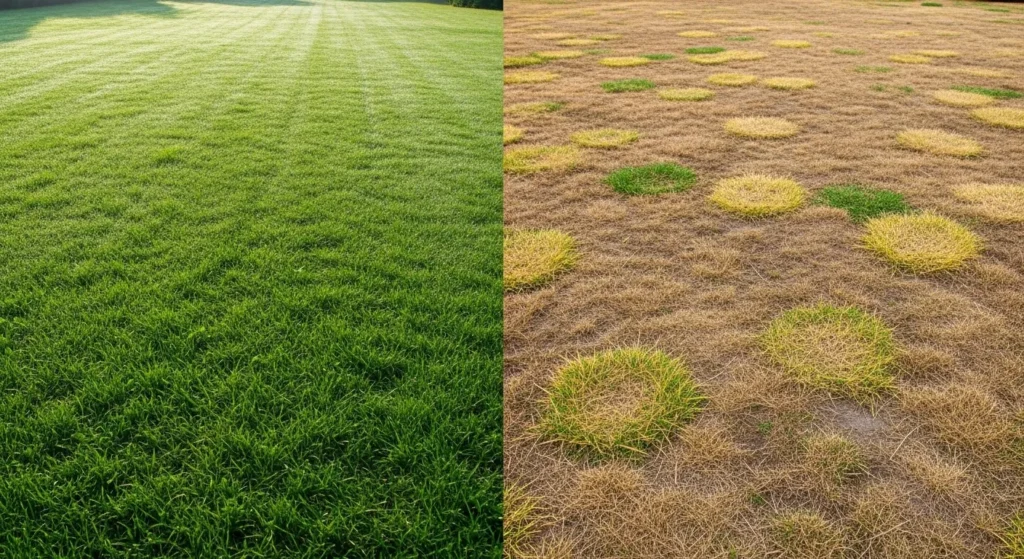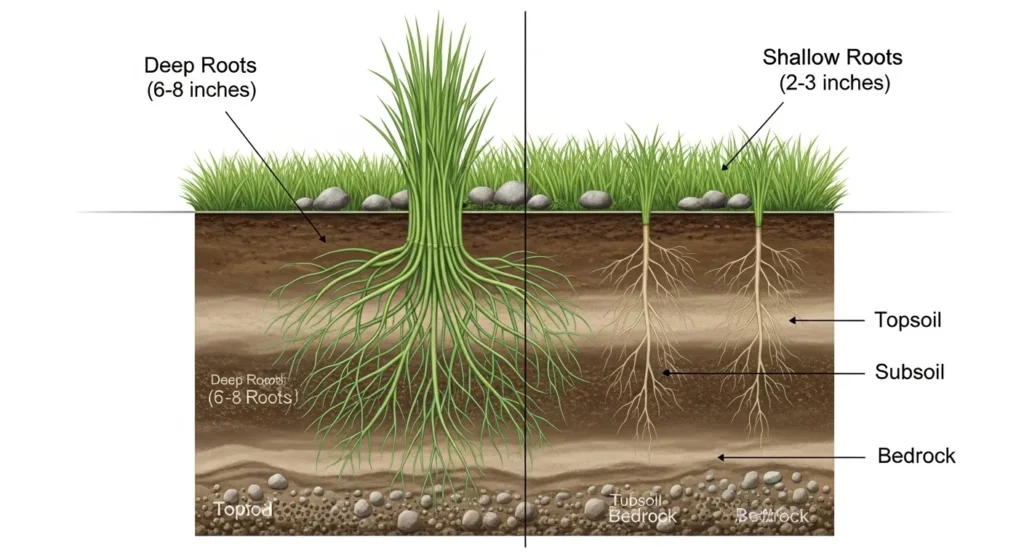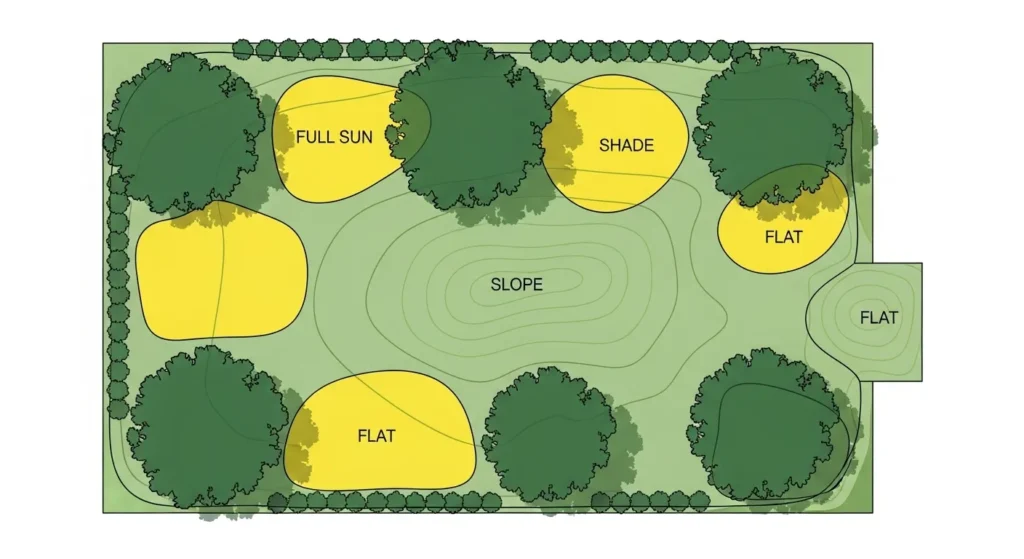Your lawn looks patchy, brown, or sickly despite regular watering. Sound familiar? You might be making common watering mistakes that actually harm your grass instead of helping it grow.
Most homeowners water their lawns incorrectly without realizing it. This guide reveals the biggest watering schedule mistakes and shows you exactly how to create a healthy, green lawn that survives hot summers and stays beautiful year-round.
Why Your Watering Schedule Matters More Than You Think
Proper watering timing and frequency directly affect your grass’s root system development and disease resistance. Both overwatering and underwatering can cause yellow-looking lawns, but overwatered grass feels spongy when you walk on it.
Getting your watering schedule right prevents:
- Root rot and fungal diseases
- Shallow root systems
- Brown patches and bare spots
- Water waste and higher bills
- Pest infestations

Mistake #1: Watering at the Wrong Time of Day
The Problem: Many people water their lawns in the evening or middle of the day.
Why It’s Wrong: The best time to water your lawn is early morning, before 10 a.m. Watering at night leaves water sitting on grass overnight, breeding fungal growth.
The Fix:
- Water between 4 a.m. and 10 a.m.
- Avoid watering during windy conditions
- Never water in the evening (after 6 p.m.)
- Skip midday watering when temperatures exceed 85°F
Why Morning Works Best:
- Cooler temperatures reduce evaporation
- Grass has time to dry before nightfall
- Less wind interference
- Better water absorption
Mistake #2: Watering Too Frequently with Shallow Sessions
The Problem: Many homeowners water their lawn every other day with short sessions.
Why It’s Wrong: Daily watering creates shallow roots that can’t survive heat stress. Your grass becomes dependent on constant moisture.
The Fix:
- Water once or twice per week for 25 to 30 minutes each session.
- Check soil moisture every 15 minutes and stop once ground is moistened to six inches deep.
- Allow 2-3 days between watering sessions
- Apply 1 inch of water per week total
Deep vs. Shallow Watering:
- Deep watering: Roots grow 6-8 inches down, grass survives drought
- Shallow watering: Roots stay near surface, grass browns quickly

Mistake #3: Ignoring Your Soil Type and Grass Species
The Problem: Using the same watering schedule regardless of soil and grass type.
Why It’s Wrong: Different areas have different water requirements – sunny spots, shaded areas, and different grass types need customized schedules.
The Fix by Soil Type:
- Clay soil: Water 2-3 times per week, shorter sessions (clay holds moisture longer)
- Sandy soil: Water more frequently, deeper sessions (sand drains quickly)
- Loamy soil: Standard schedule works (1-2 times per week)
The Fix by Grass Type:
- Cool-season grasses (fescue, bluegrass): Need more water in summer
- Warm-season grasses (Bermuda, Zoysia): More drought tolerant, less frequent watering
- New grass: Daily light watering until established (2-3 weeks)
For more guidance on choosing the right grass for your area, check out our guide to the best grass types for different climates.
Mistake #4: Not Recognizing Overwatering vs. Underwatering Signs
The Problem: Both overwatering and underwatering can cause similar symptoms, leading to wrong solutions.
Overwatering Signs:
- Mushy soil, yellowing grass, lots of mushrooms or fungus, and water runoff
- Spongy feel when walking on grass
- Standing water or soggy soil
- Increased pest problems
Underwatering Signs:
- Grass feels dry and crispy, leaves curl, and footprints stay visible on the lawn
- Brown patches that feel dry
- Grass blades fold or wilt
- Hard, compacted soil
The Fix:
- Screwdriver test: Push a screwdriver into soil. It should penetrate 6 inches easily when properly watered.
- Footprint test: Walk across your lawn. If footprints remain visible for more than a few seconds, you need water.
- Color check: Healthy grass is deep green. Dull green or blue-gray indicates water stress.
Mistake #5: Watering Every Area the Same Amount
The Problem: Using uniform watering across the entire lawn, which results in overwatering some areas while under-watering others.
Why It’s Wrong: Different areas of your yard have different needs:
- Slopes drain faster and need more water
- Shaded areas need less water
- Areas near trees compete for moisture
- South-facing slopes get more sun and heat
The Fix – Zone Your Watering:
- Zone 1: Full sun areas – standard watering schedule
- Zone 2: Shaded areas – reduce watering by 30-40%
- Zone 3: Slopes and sandy areas – increase frequency, shorter sessions
- Zone 4: Areas near trees – increase watering time
Pro Tip: Install separate sprinkler zones or use a hose-end sprinkler with adjustable patterns for different areas.

Mistake #6: Ignoring Seasonal Adjustments
The Problem: Using the same watering schedule year-round.
Why It’s Wrong: Grass needs change dramatically with seasons, temperature, and rainfall.
Seasonal Watering Schedule:
Spring (March-May):
- Start with 2 times per week as grass comes out of dormancy
- Adjust based on rainfall
- Focus on helping grass establish after winter
Summer (June-August):
- Peak watering season – 1-2 times per week
- Water early morning only
- Most grass types need about 1 inch of water per week
- Monitor for heat stress signs
Fall (September-November):
- Reduce frequency as temperatures drop
- Continue until first frost
- Prepare grass for winter dormancy
Winter (December-February):
- Stop watering in most climates
- Only water if temperatures exceed 40°F for several days
- Focus on lawn preparation for spring
Mistake #7: Not Accounting for Natural Rainfall
The Problem: Watering on schedule regardless of recent rain.
Why It’s Wrong: Overwatering can lead to diseases, weeds, and insect pests. You’re also wasting water and money.
The Fix:
- Install a rain gauge in your yard
- Check weather forecasts before watering
- Skip watering if you’ve received 0.5+ inches of rain in the past week
- Use smart sprinkler controllers that adjust for weather
Rain Measurement Guide:
- 0.25 inches: Light rain, continue normal schedule
- 0.5-1 inch: Skip one watering session
- 1+ inches: Skip watering for 3-5 days
How to Create the Perfect Watering Schedule
Follow these steps to develop a customized watering schedule:
- Test your sprinkler output: Place containers around your yard and run sprinklers for 15 minutes. Measure water depth to calculate delivery rate.
- Determine your grass type and soil: This affects how much and how often you water.
- Create a baseline schedule:
- Start with 2 sessions per week, 25-30 minutes each
- Adjust based on soil type and grass species
- Monitor and adjust:
- Check soil moisture regularly
- Watch for over/underwatering signs
- Adjust for weather and seasons
- Set up automation: Use programmable timers or smart controllers to maintain consistency.
Quick Reference: Healthy Lawn Watering Checklist
Weekly Tasks:
- Check soil moisture before each watering session
- Water 2 times maximum (Monday/Thursday works well)
- Apply 0.5 inches of water per session
- Water between 4-10 a.m. only
Monthly Tasks:
- Measure actual sprinkler output with containers
- Adjust schedule based on rainfall
- Check for signs of over/underwatering
- Clean and maintain sprinkler heads
Seasonal Tasks:
- Adjust schedule for temperature changes
- Modify watering zones based on sun patterns
- Prepare equipment for season changes
- Review and update automation settings
Common Questions About Lawn Watering
How long should I water my lawn? Water for 25-30 minutes per session, twice per week. Adjust based on your sprinkler’s output rate and soil type.
What if my grass is still brown after proper watering? Brown grass despite proper watering usually indicates other issues like disease, pests, or soil problems. Consider a soil test or consult a lawn care professional.
Can I water during a drought? Check local water restrictions first. During drought, focus on keeping grass alive rather than green. Water less frequently but more deeply.
Should I water new grass differently? Yes, new grass needs daily light watering for the first 2-3 weeks until roots establish. Then gradually transition to normal watering schedule.
The Bottom Line
Most lawn watering problems come from timing and frequency mistakes, not the amount of water. Water early morning, stick to 1-2 sessions per week, and adjust for your specific conditions.
Remember that an underwatered lawn can usually be repaired in a few weeks while an overwatered lawn may take many months to repair. When in doubt, water less frequently but more deeply.
Your lawn will reward proper watering with deep roots, vibrant color, and natural resistance to pests and diseases. Start implementing these changes this week and watch your grass transform into the healthy, green lawn you’ve always wanted.
